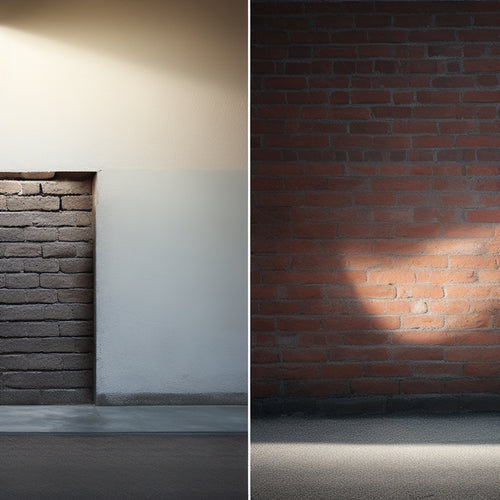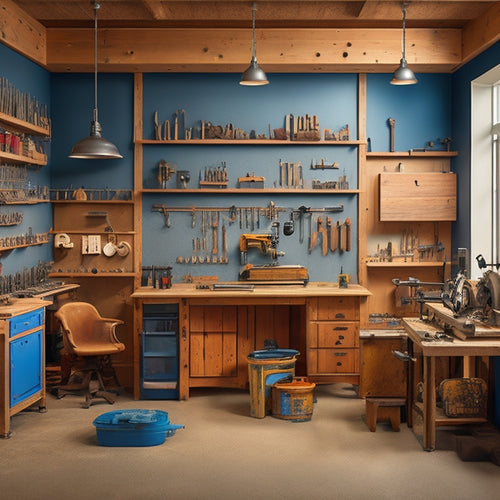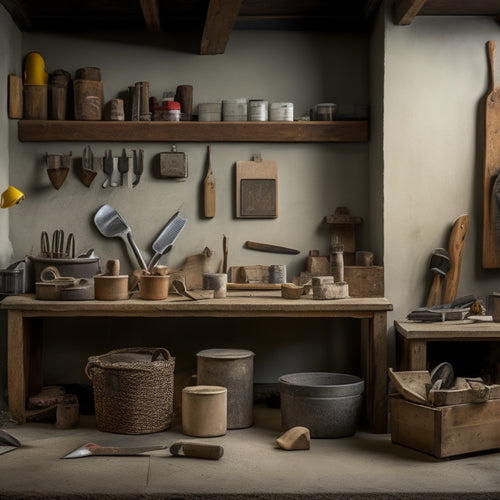
Top Tools for Mixing and Fixing Renovation Concrete
Share
When mixing and fixing renovation concrete, you'll need a range of essential tools to guarantee efficiency and accuracy. Start with a sturdy mixing bucket, a reliable shovel, and a versatile trowel for applying and smoothing the concrete. Add specialized tools like edging tools, floating tools, and tamping equipment to perfect the finish. Don't forget measuring devices, wheelbarrows, and concrete cutting tools for precise cuts. Finally, consider specialized concrete repair kits for addressing imperfections. With these tools in your arsenal, you'll be well-equipped to tackle your renovation project - and by exploring each type in more detail, you'll uncover the secrets to achieving a flawless concrete finish.
Key Takeaways
• Essential mixing tools include buckets, shovels, trowels, and mixing techniques to ensure accurate concrete ratios and efficient mixing.
• Finishing tools like edgers, floats, and trowels are necessary for creating a smooth, high-gloss finish and removing imperfections.
• Tamping equipment, including hand tampers, plate compactors, and tamping rakes, helps remove air pockets and excess water for a smooth surface.
• Measuring devices like laser distance meters, digital calipers, and leveling tools ensure accurate calculations and precise measurements for renovation projects.
• Specialized concrete repair kits with epoxy resins and polyurethane foams help address imperfections like cracks and unevenness in renovation concrete.
Essential Concrete Mixing Tools
When preparing for a renovation project, you'll need to gather vital concrete mixing tools to guarantee a strong and durable concrete mix. A mixing bucket, shovel, and trowel are must-haves for any concrete project. These tools will allow you to efficiently mix and apply the concrete, ensuring a smooth and even finish.
Additionally, you'll need to contemplate the type of mixing techniques you'll use, such as machine mixing or hand mixing, and the specific tools required for each method.
Concrete additives, such as accelerators, retarders, and air-entraining agents, can also impact the final product. These additives can be used to improve the workability, strength, and durability of the concrete. It's crucial to understand how to properly use these additives to achieve the desired results.
High-Quality Tamping Equipment
You'll need high-quality tamping equipment to compact and finish the freshly poured concrete, guaranteeing it achieves the desired density and smoothness. This is vital for a successful renovation project. When selecting tamping equipment, consider the type of concrete, slab size, and desired finish.
| Tamping Equipment | Description | Benefits |
|---|---|---|
| Hand tamper | A manual tool used for small areas and tight spaces | Cost-effective, easy to use |
| Plate compactor | A walk-behind or ride-on machine for large areas | Fast, efficient, and effective |
| Tamping rake | A long-handled tool with a flat or curved blade | Allows for precise control, ideal for small areas |
To get the most out of your tamping equipment, it's important to master tamping techniques, such as using the correct tempo and applying even pressure. Regular equipment maintenance is also significant, as it can affect the quality of the finish. Make sure to clean and lubricate your equipment regularly to guarantee peak performance. By choosing the right tamping equipment and following proper techniques, you'll be able to achieve a high-quality finish that meets your renovation goals.
Best Concrete Finishing Tools
As you move on to the finishing stage of your concrete renovation project, you'll need to master smooth finishing techniques to achieve a professional-looking result.
You'll also need to choose the right concrete trowel options for your specific job, considering factors like size, material, and handle type.
Additionally, you'll want to understand the proper use of edging and floating tools to create clean lines and a smooth, even surface.
Smooth Finishing Techniques
Achieving a smooth finish on your renovation concrete project relies on selecting the best concrete finishing tools and mastering the techniques to wield them effectively. To get the desired results, you need to understand the importance of surface preparation and smoothing techniques.
| Technique | Tool | Description |
|---|---|---|
| Floating | Bull Float | Used to level and smooth the surface, removing excess material |
| Tamping | Hand Tamper | Compacts the concrete, ensuring a solid base |
| Edging | Edger | Creates a clean, defined edge around the perimeter |
| Finishing | Finishing Trowel | Achieves a high-gloss, smooth finish |
Concrete Trowel Options
Multiple concrete trowel options are available for selecting the best concrete finishing tool to suit your specific renovation project needs. You'll want to take into account the type of trowel and its material to guarantee a smooth, even finish.
There are three primary trowel types: V-trowels, square-notched trowels, and round-edged trowels. Each is designed for specific applications, such as applying thin layers of concrete or creating textured surfaces.
When it comes to trowel materials, you'll find options ranging from stainless steel to aluminum and even plastic. Stainless steel trowels are ideal for heavy-duty use and resist corrosion, while aluminum trowels are lighter and more suitable for smaller projects.
Plastic trowels are a cost-effective option for DIYers, but may not withstand heavy use. Take into account the size and weight of the trowel, as well as its handle material and grip, to guarantee comfortable use.
Edging and Floating
When finishing a concrete surface, you'll need to choose the right edging and floating tools to guarantee a seamless joint and a smooth, even finish. Edging techniques involve creating a defined edge, while floating methods help to smooth out the surface.
To achieve a professional-looking finish, consider the following tools:
| Tool | Description |
|---|---|
| Edger | Creates a clean, defined edge between concrete and adjacent surfaces |
| Float | Smooths out the surface, removing imperfections and air pockets |
| Tamping Float | Combines floating and tamping actions to compact and smooth the surface |
Remember to select the right tool for your specific project needs. For example, an edger is ideal for creating a clean joint between concrete and a wall, while a float is better suited for large, open areas. By mastering edging and floating techniques, you'll be able to achieve a high-quality finish that enhances the overall appearance of your renovation project.
Reliable Concrete Cutting Tools
You'll need concrete cutting tools that can withstand the rigors of renovation projects, reliably slicing through thick slabs and stubborn foundations. When it comes to concrete cutting, you have several diamond blade options to choose from. These blades are designed to withstand the abrasive nature of concrete, providing a smooth and precise cut. For larger projects, consider investing in a high-performance diamond blade that can handle heavy-duty cutting.
For smaller, more precise cuts, a portable saw is an excellent choice. Be sure to read portable saw reviews to find the best one for your specific needs. Look for features such as adjustable cutting depths, ergonomic handles, and durable blades.
A good portable saw will make quick work of small concrete cutting tasks, saving you time and effort. By investing in reliable concrete cutting tools, you'll be able to tackle even the toughest renovation projects with confidence.
Remember to always follow safety guidelines and wear protective gear when operating concrete cutting tools.
Must-Have Measuring Devices
Accurate measurements are essential in renovation projects, and having the right measuring devices guarantees that your concrete mixing and fixing tasks are done efficiently and effectively. You'll avoid costly mistakes and verify that your concrete mixture is proportioned correctly.
Here are the must-have measuring devices you should have in your toolkit:
-
Laser Distance Meter: This handy tool measures distances accurately and quickly, allowing you to calculate the volume of concrete needed for your project.
-
Digital Calipers: These precise calipers help you measure the diameter of reinforcement bars, pipe fittings, and other materials with ease.
-
Measuring Tape: A sturdy, 25-foot measuring tape is a classic tool that's essential for measuring rooms, walls, and other surfaces.
Top Concrete Mixing Buckets
Five essential concrete mixing buckets should be in your renovation toolkit, each designed to streamline your mixing and fixing tasks.
When selecting a mixing bucket, consider the materials it's made of. You'll want a bucket that's durable, resistant to abrasion, and easy to clean. Polypropylene and steel buckets are popular choices, as they're robust and can withstand harsh construction environments.
Bucket size considerations are also important. A larger bucket may seem ideal, but it can be cumbersome and difficult to handle. On the other hand, a smaller bucket may not hold enough material for your project. Choose a bucket that's the right size for your specific needs. Typically, buckets range from 1-5 gallons. Consider the quantity of concrete you'll be mixing and the space you have available on-site.
Additionally, look for buckets with features like non-slip handles, graduated measurements, and a sturdy design. These features will make mixing and pouring concrete easier and more efficient.
Heavy-Duty Wheelbarrows Needed
When you're working with heavy concrete loads, you'll need a wheelbarrow that can handle the weight.
You're looking for a model with a high load capacity to prevent accidents and guarantee efficient transport.
Load Capacity Matters
Your heavy-duty wheelbarrow's load capacity is critical to efficiently transporting renovation concrete tools and materials around the job site, as it directly impacts your productivity and safety.
You need to take into account the weight of the concrete, tools, and other materials you'll be transporting to guarantee your wheelbarrow can handle the load. Overloading can lead to accidents, damage to the wheelbarrow, and even injury.
Here are three key factors to take into account when evaluating a wheelbarrow's load capacity:
-
Structural integrity: The wheelbarrow's frame and axle should be able to withstand the weight of the load without compromising its structural integrity.
-
Load distribution: The weight of the load should be evenly distributed across the wheelbarrow's frame to prevent tipping or collapse.
-
Material strength: The wheelbarrow's materials should be able to support the weight of the load without compromising its strength or durability.
Durable Construction Counts
In renovation concrete projects, you require a heavy-duty wheelbarrow that can withstand the rigors of frequent use and harsh job site conditions, emphasizing the importance of durable construction in your wheelbarrow selection.
A wheelbarrow that's built to last will save you time and money in the long run. When evaluating wheelbarrows, look for ones that have undergone rigorous durability testing, such as drop tests, load tests, and exposure to extreme temperatures. This guarantees that the wheelbarrow can handle the demands of a construction site.
Additionally, consider a wheelbarrow with weather-resistant features, such as a rust-proof frame, waterproof trays, and UV-resistant tires. These features will help protect your wheelbarrow from the elements, reducing maintenance and extending its lifespan.
By choosing a wheelbarrow with durable construction, you'll be able to focus on getting the job done efficiently, rather than worrying about equipment failures.
Concrete Smoothing Tools Required
As you prepare to smooth out your freshly poured concrete, you'll need a set of specialized tools to achieve a uniform, even finish.
Concrete surface preparation is an essential step in ensuring ideal smoothing techniques, and having the right tools is vital.
Here are the top concrete smoothing tools you'll need:
-
Tamping tool: This tool helps to remove any air pockets and excess water from the concrete surface, allowing for a smooth finish.
-
Float: A float is used to spread and level the concrete, creating a uniform surface.
-
Trowel: A trowel is used for the final smoothing process, allowing you to achieve a high-gloss finish.
Specialized Concrete Repair Kits
You'll need specialized concrete repair kits to address imperfections that may arise during the smoothing process, such as cracks or unevenness.
These kits usually come with a combination of materials, like epoxy resins, polyurethane foams, or cement-based compounds, designed to tackle specific repair tasks. When selecting a repair kit, consider the type of repair you need to make and the environmental conditions the concrete will be exposed to. For instance, if you're dealing with a hairline crack, an epoxy-based kit might be suitable. For larger cracks or holes, a polyurethane foam kit could be more effective.
Different repair kit types require unique application techniques. For example, epoxy-based kits often involve mixing the resin and hardener, then applying the mixture to the affected area. Polyurethane foam kits, on the other hand, typically involve injecting the foam into the crack or hole, allowing it to expand and fill the gap.
It's important to follow the manufacturer's instructions and take necessary safety precautions, such as wearing gloves and working in a well-ventilated area, to guarantee a successful repair.
Frequently Asked Questions
Can I Mix Concrete in a Plastic Bucket Instead of a Metal One?
When you mix concrete, you can use a sturdy plastic bucket, but make certain it's durable enough to withstand the mixing process; however, metal buckets are often preferred due to their strength and resistance to wear.
How Do I Prevent Concrete From Sticking to My Tools and Equipment?
You're tempted to scratch and scrape, but don't; instead, apply a concrete release agent to your tools and equipment to prevent sticking, then prioritize tool maintenance to guarantee a smooth, efficient renovation process.
What Is the Ideal Temperature for Mixing and Pouring Concrete?
When mixing concrete, you'll want to maintain an ideal temperature between 50°F and 75°F to guarantee proper hydration and strength development, as extreme temperatures can negatively impact concrete temperature effects and ideal mixing conditions.
Can I Use a Regular Drill to Mix Small Batches of Concrete?
While you might think a regular drill can handle small concrete batches, it's not the best choice; instead, opt for a heavy-duty drill or mixing drill with a paddle bit, ensuring effective mixing techniques for a strong, consistent mix.
How Long Does It Take for Concrete to Fully Cure and Harden?
You'll wait around 28 days for concrete to fully cure and harden, as the hydration process slowly progresses, with the curing time influenced by factors like temperature, humidity, and mix design.
Conclusion
You've made it to the end of this thorough guide to top tools for mixing and fixing renovation concrete.
With these essential tools, you'll be well-equipped to tackle any concrete project.
Did you know that the US construction industry uses over 500 million tons of concrete annually?
That's equivalent to laying a two-lane highway from New York to Los Angeles and back again!
Now, get out there and start building with confidence.
Related Posts
-

Why Use Concrete Blocks in Home Renovation
You're considering using concrete blocks in your home renovation, and for good reason: they offer a unique combinatio...
-

Renovation Tool Checklist for Smooth Finishes
When tackling a renovation project that requires a smooth finish, you'll need a thorough tool checklist to guarantee ...
-

3 Beginner-Friendly Tools for Plaster Renovation Success
You'll be glad to know that the three essential tools you need for a successful plaster renovation are the same ones ...


